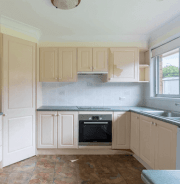What is the resurfacing process?
Resurfacing is just what it sounds like as the top layer is removed, small cracks are patched if required, and a new surface is added using a resurfacer instead of removing them. Although the resurfacer looks like standard concrete and works, it is not precisely the same. Kitchen and bathroom resurfacing are majorly done at homes.
Is kitchen and bathroom resurfacing covered by a warranty?
Our kitchen and bathroom resurfacing services are covered by a warranty, for resurfaced bathtubs and countertops; a one-year restricted warranty applies unless an extended warranty has been obtained.
Warranty shall not be extended if the original porcelain/fibreglass is damaged or if delamination is caused by pooling water, dripping faucets, suction devices or bath mat goods, misuse, and damage fixture repair, chemical dissolution, corrosion or damage beyond our ability to determine the cause of the problem.
Warranty shall not be extended if the original porcelain/fibreglass is damaged or if delamination is caused by pooling water, dripping faucets, suction devices or bath mat goods, misuse, and damage fixture repair, chemical dissolution, corrosion or damage beyond our ability to determine the cause of the problem.
How long does resurfacing last?
That depends on several factors since there are no two similar paving projects. Factors that decide the lifetime of kitchen and bathroom resurfacing include the weather conditions, the harshness of the winter, how often the areas are used, the thickness of the new asphalt layer, the actual state of the subgrade before resurfacing and how well the new surface is maintained daily.
How long before I can use my newly resurfaced area?
A day is actually enough before the resurfaced area can be used again. But that can also depend on the type of activities to be conducted on the kitchen and bathroom resurfaced area. All precautions need to be taken care of after resurfacing is completed.
Is resurfacing a disruptive process?
Every precaution is taken to avoid any on-site disruption, using effective control methods and techniques to secure your home and furniture. Before kitchens and bathrooms resurfacing, we create a mini spray booth where planning and resurfacing takes place.








